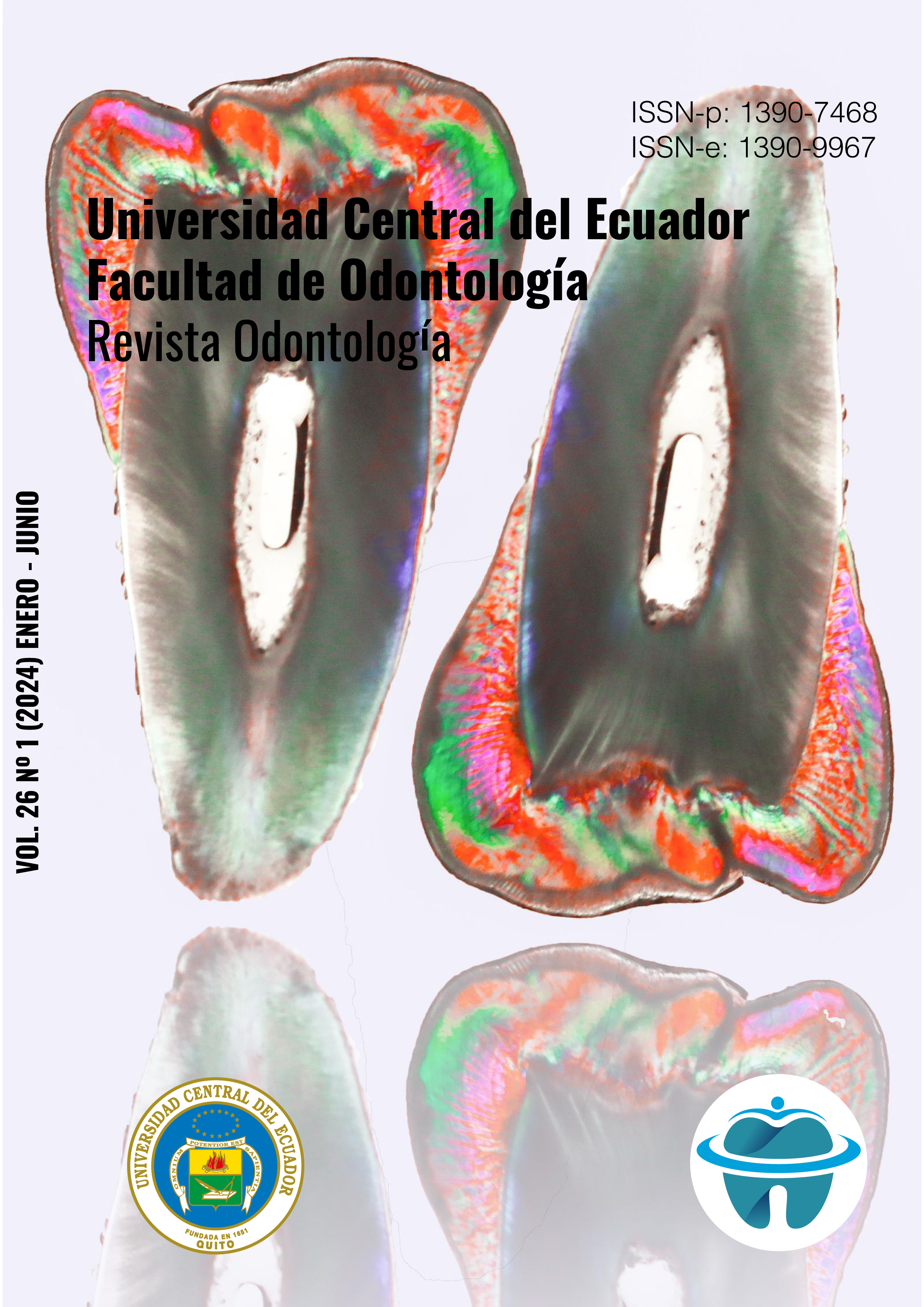Analysis of adhesive techniques in dental sealants: an experimental study on premolars
DOI:
https://doi.org/10.29166/odontologia.vol26.n1.2024-e5909Keywords:
microleakage, adhesives, pit and fissure sealantsAbstract
Objetive: To identify which of the adhesive techniques presents greater microleakage. Methodology: In vitro experimental study, in which 60 premolars divided randomly into 4 groups were used. Group 1 (CT): conventional technique, conditioning with 37% orthophosphoric acid and sealant, Group 2 (GAA): acid conditioning, application of etching and rinsing adhesive and sealant, Group 3 (GAS): application of universal adhesive and sealant, Group 4 (GAAS): acid conditioning, application of universal adhesive and sealant. All samples were thermocycled at 10,000 cycles, and then they were immersed for 24 hours in a 0.5% methylene blue solution and were sectioned buccolingually to evaluate microleakage in a stereomicroscope. The data were evaluated in the statistical software Minitab 19 with a confidence level of 95%. An ANOVA analysis was applied with a Tukey post-hoc (α=0.05). Results: the GAS group was the one that presented the highest degree of microleakage (mean=1,667), compared to the GAA group that had the lowest degree of microleakage (mean=1,000). However, there were no statistical differences between the GAS, TC, and GAAS adhesive technique groups, nor between the TC, GAAS, and GAA groups. Conclusions: The use of a resinous sealant with universal adhesive without previous acid etching was the one that presented the greatest microleakage.
Downloads
References
Mehrabkhani M, Mazhari F, Sadeghi S, Ebrahimi M. Effects of sealant, viscosity, and bonding agents on microleakage of fissure sealants: An in vitro study. European Journal of Dentistry. 2015;9(4):558–63.
Bagherian A, Sarraf Shirazi A, Sadeghi R. Adhesive systems under fissure sealants: Yes or no? A systematic review and meta-analysis. J Am Dent Assoc. 2016;147(6):446–56.
Crispín BAS, Juventino PC, Hilda IH, Ivonne PII, Rogelio OP, Eymard. TTS. Microfiltración de tres selladores de fosetas y fisuras con diferentes estructuras de relleno: estudio in vitro. Rev AMOP. 2017;29(1):6–20.
Garg D, Mahabala K, Lewis A, Natarajan S, Nayak A, Rao A. Comparative evaluation of sealing ability, penetration and adaptation of a self etching pit and fissure sealant-stereomicroscopic and scanning electron microscopic analyses. J Clin Exp Dent. 2019;11(6):547–52.
Tirali R, Çelik C, Arhun N, Berk G, Cehreli S. Effect of Laser and Air Abrasion Pretreatment on the Microleakage of a Fissure Sealant Applied with Conventional and Self Etch Adhesives. J Clin Pediatr Dent. 2013;37(3):281–8.
Nahvi A, Razavian A, Abedi H, Charati JY. A comparison of microleakage in self-etch fissure sealants and conventional fissure sealants with total-etch or self-etch adhesive systems. Eur J Dent. 2018;12(2):242–6.
Tehrani MH, Birjandi N, Nasr E, Shahtusi M. Comparison of microleakage of two materials used as fissure sealants with different methods: an in vitro study. Int J Prev Med. 2014;5(2):171–5.
Topaloglu-Ak A, Önçağ Ö, Gökçe B, Bent B. The effect of different enamel surface treatments on microleakage of fissure sealants Operative control of dental caries. Acta Med Acad. 2013;42(2):223–8.
Botsali M, Küçükyilmaz E, Gül T, Altunsoy M, Şener Y. Effects of adhesive systems applied under fissure sealants to microleakage and shear bond strength. 2020;32(2):63–7.
Tulunoglu O 8, Lu ˘, Bodur H, Tas¸li C¸. The effect of bonding agents on the microleakage and bond strength of sealant in primary teeth. J Oral Rehabil. 1999;26:436–41.
Licla K, Albites U. Grado de microfiltración de un sellante resinoso con diferentes sistemas adhesivos. Odontol Pediatr. 2015;14(2):120–9.
Hannig M, Gräfe A, Atalay S, Bott B. Microleakage and SEM evaluation of fissure sealants placed by use of self-etching priming agents. J Dent. 2004;32(1):75–81.
Celiberti P, Lussi A. Use of a self-etching adhesive on previously etched intact enamel and its effect on sealant microleakage and tag formation. J Dent. 2005;33(2):163–71.
Kanemura N, Sano H, Tagami J. Tensile bond strength to and SEM evaluation of ground and intact enamel surfaces. J Dent. 1999;27(7):523–30.
Seraj B, Meighani G, Milani S, Fatemi M. Effect of Precuring and Postcuring of Total-Etch and Self-Etch Bonding Agents on the Microleakage of Fissure Sealants. Frontiers in Dentistry. 2019;16(6):421-28
Urquía MC, Brasca N, Girardi M, Bonnin C, Ríos M. In vitro study of microleakage of fissure sealant with different previous treatments. Acta Odontol Latinoam. 2011;24(2):150–4.
Padrós-Serrat JL, Monterrubio-Berga M, Padrós-Cruz E. Adhesivos autograbantes: ¿Grabar o no grabar? Rcoe. 2003;8(4):363–75.
Perdigão J, Geraldeli S. Bonding characteristics of self-etching adhesives to intact versus prepared enamel. J Esthet Restor Dent. 2003;15(1):32–42.
Erbas Unverdi G, Atac SA, Cehreli ZC. Effectiveness of pit and fissure sealants bonded with different adhesive systems: a prospective randomized controlled trial. Clin Oral Investig. 2017;21(7):2235–43.
Nejad SJ, Razavi M, Birang R, Atefat M. In vitro study of microleakage of different techniques of surface preparation used in pits and fissures. Indian J Dent Res. 2012;23(2):247-50.
Usha M D, Suma G. Bonding agents in pit and fissure sealants: a review. Int J Clin Pediatr Dent. 2009;2(3):1-6.
Published
How to Cite
Issue
Section
License
Copyright (c) 2024 Evelyn Benavides Morejon, Inés Villacís-Altamirano

This work is licensed under a Creative Commons Attribution-NonCommercial-NoDerivatives 4.0 International License.


